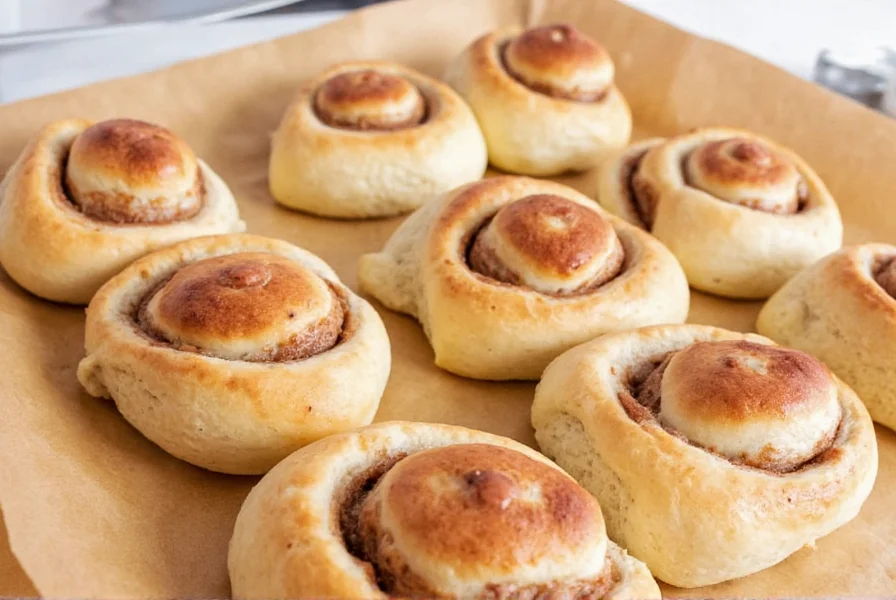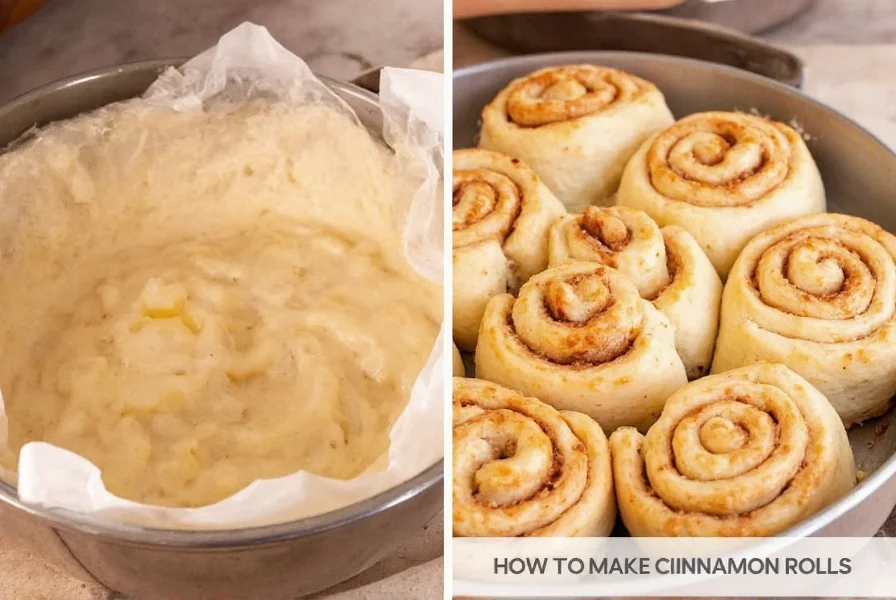The Ultimate Guide to Making Perfect Cinnamon Rolls from Scratch
There's nothing quite like the aroma of freshly baked cinnamon rolls filling your kitchen. While store-bought options exist, nothing compares to homemade cinnamon rolls with their tender, pillowy texture and rich cinnamon flavor. This comprehensive guide walks you through every step to create bakery-quality cinnamon rolls in your own kitchen.
Essential Ingredients for Homemade Cinnamon Rolls
Using quality ingredients makes all the difference in your homemade cinnamon rolls recipe. Here's what you'll need:
| Category | Ingredients | Measurement |
|---|---|---|
| Dough | All-purpose flour | 4½ cups (560g) |
| Dough | Warm whole milk (110°F) | 1 cup (240ml) |
| Dough | Unsalted butter, melted | ⅓ cup (75g) |
| Dough | Granulated sugar | ⅓ cup (65g) |
| Dough | Active dry yeast | 2¼ tsp (7g) |
| Dough | Eggs, room temperature | 2 large |
| Filling | Packed brown sugar | 1 cup (220g) |
| Filling | Ground cinnamon | 2 tbsp |
| Filling | Unsalted butter, softened | ⅓ cup (75g) |
| Frosting | Cream cheese, softened | 4 oz (115g) |
| Frosting | Powdered sugar | 1½ cups (180g) |
Equipment You'll Need
- Stand mixer with dough hook (or large mixing bowl)
- Rolling pin
- 9x13 inch baking pan
- Pastry brush
- Sharp knife or dental floss for cutting
- Kitchen thermometer (for milk temperature)
Step-by-Step Instructions for Perfect Cinnamon Rolls
1. Prepare the Yeast Dough
Combine warm milk (110°F is crucial—too hot kills yeast, too cold won't activate it), sugar, and yeast in a bowl. Let sit for 5-10 minutes until foamy. This step ensures your best cinnamon roll dough starts with active yeast.
In a stand mixer bowl, combine 2 cups of flour and melted butter. Add the yeast mixture and eggs. Mix on low speed until combined. Gradually add remaining flour, ½ cup at a time, until a soft dough forms. Knead for 5-7 minutes until smooth and elastic.
2. First Rise
Place dough in a lightly greased bowl, cover with plastic wrap, and let rise in a warm place for 1-1.5 hours, or until doubled in size. Proper proofing is essential for how to make soft cinnamon rolls with that signature airy texture.
3. Roll Out and Fill
Punch down risen dough and roll out on a floured surface into a 16x12 inch rectangle. Spread softened butter evenly over the dough, leaving a ½ inch border. Mix brown sugar and cinnamon, then sprinkle evenly over the butter.
4. Roll and Cut
Tightly roll the dough starting from the long side. Pinch the seam to seal. Using a sharp knife or unflavored dental floss (which creates cleaner cuts), slice into 12 equal pieces. Place rolls cut-side down in a greased 9x13 inch pan.

5. Second Rise
Cover the pan and let rolls rise for 30-45 minutes until puffy and nearly doubled. This second rise develops the perfect texture for your classic cinnamon roll filling to shine.
6. Bake to Perfection
Preheat oven to 350°F (175°C). Bake for 20-25 minutes until golden brown. The ideal cinnamon roll baking temperature ensures even cooking without burning. Rolls are done when internal temperature reaches 190°F (88°C).
7. Prepare the Cream Cheese Frosting
While rolls bake, beat cream cheese and butter until smooth. Gradually add powdered sugar, vanilla, and milk until desired consistency. Drizzle over warm rolls.
Pro Tips for Cinnamon Roll Success
- Yeast activation is critical: Milk temperature must be 105-115°F for optimal yeast activity in your yeast dough for cinnamon rolls
- Cutting technique matters: Use dental floss to slice rolls for clean edges without squishing
- Avoid overbaking: Remove rolls when they're golden but still soft—they continue cooking off-heat
- Room temperature ingredients: Cold ingredients create uneven dough and affect rise
- Don't skip the second rise: This develops flavor and creates that signature pull-apart texture
Troubleshooting Common Cinnamon Roll Problems
Dense rolls: Usually caused by too much flour, inactive yeast, or insufficient rising time. Measure flour properly by spooning into measuring cup and leveling.
Filling leaking out: Apply filling evenly but not too close to edges, and roll tightly. Chilling rolls for 15 minutes before baking can help prevent leakage in your easy cinnamon roll instructions.
Burnt bottoms: Place baking pan on a lower rack or use a double pan to distribute heat more evenly during how long to bake cinnamon rolls.
Variations to Try
- Apple cinnamon rolls: Add finely diced apples to the filling
- Streusel topping: Replace frosting with a crumbly streusel topping
- Maple glaze: Substitute maple syrup for some of the milk in the frosting
- Overnight cinnamon rolls: Prepare rolls, place in pan, cover, and refrigerate overnight. Let sit at room temperature for 1 hour before baking
Storing and Reheating Tips
Store cooled, unfrosted rolls in an airtight container for up to 2 days at room temperature or freeze for up to 3 months. To reheat, microwave individual rolls for 15-20 seconds or warm in a 300°F oven for 10 minutes. Add fresh frosting after reheating for best results.
Frequently Asked Questions
How do I know when my cinnamon rolls are done baking?
Cinnamon rolls are done when they reach an internal temperature of 190°F (88°C) and are golden brown on top. They should spring back when lightly touched. Overbaking causes dryness, so check at the 20-minute mark.
Can I make cinnamon rolls without a stand mixer?
Yes, you can make cinnamon rolls by hand. Mix ingredients in a large bowl and knead the dough on a floured surface for 8-10 minutes until smooth and elastic. The process takes more effort but produces the same delicious results as machine-kneaded dough.
Why did my cinnamon rolls come out dense?
Dense cinnamon rolls typically result from too much flour, inactive yeast, or insufficient rising time. Measure flour properly by spooning into the cup and leveling, ensure milk is 105-115°F to activate yeast, and allow full rising time until doubled in size.
How can I prevent my cinnamon filling from leaking out during baking?
To prevent filling leakage, spread the cinnamon-sugar mixture evenly but leave a ½-inch border around the edges. Roll the dough tightly and pinch the seam to seal. Chilling the cut rolls for 15 minutes before baking helps the filling set and reduces leakage.
Can I prepare cinnamon rolls the night before?
Yes, you can make overnight cinnamon rolls. After cutting and placing in the pan, cover tightly and refrigerate for up to 18 hours. The next morning, let them sit at room temperature for 1 hour before baking. This method develops deeper flavor and saves morning preparation time.











 浙公网安备
33010002000092号
浙公网安备
33010002000092号 浙B2-20120091-4
浙B2-20120091-4